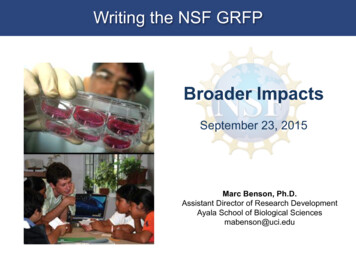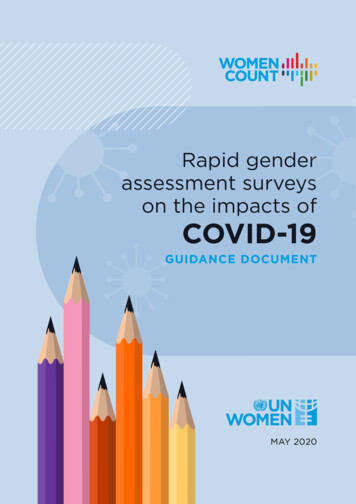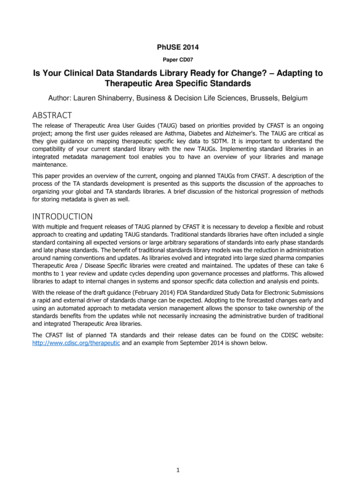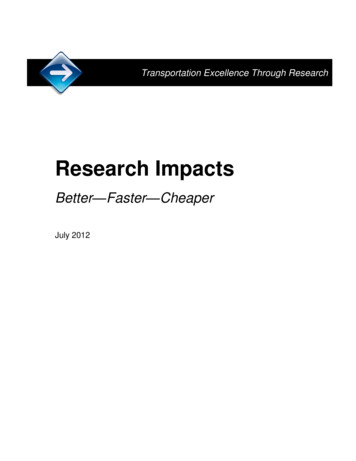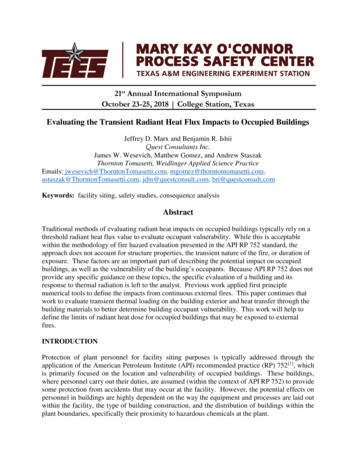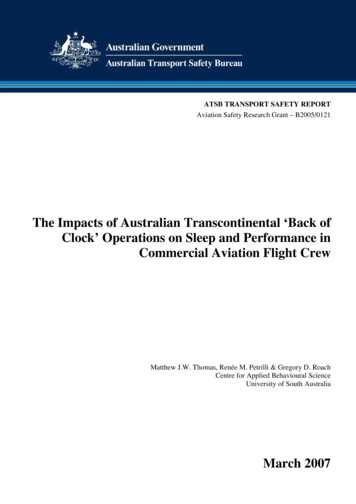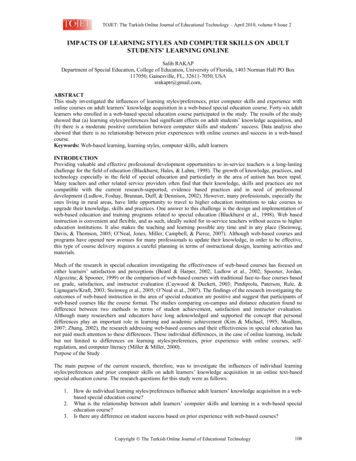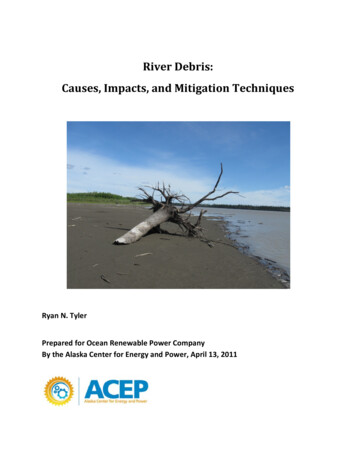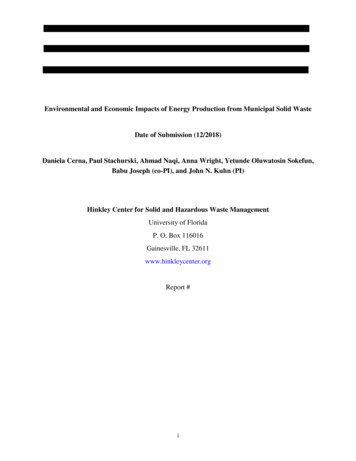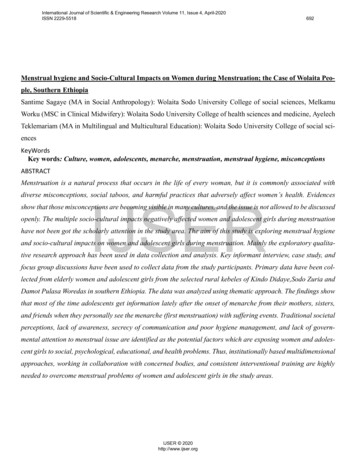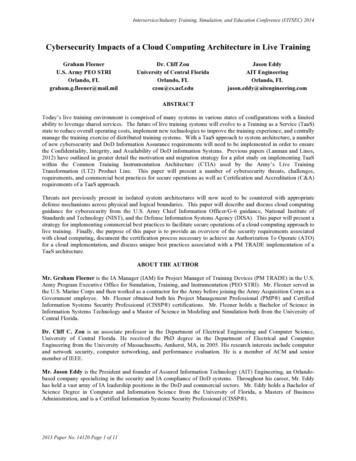
Transcription
Interservice/Industry Training, Simulation, and Education Conference (I/ITSEC) 2014Cybersecurity Impacts of a Cloud Computing Architecture in Live TrainingGraham FleenerU.S. Army PEO STRIOrlando, FLgraham.g.fleener@mail.milDr. Cliff ZouUniversity of Central FloridaOrlando, FLczou@cs.ucf.eduJason EddyAIT EngineeringOrlando, FLjason.eddy@aitengineering.comABSTRACTToday’s live training environment is comprised of many systems in various states of configurations with a limitedability to leverage shared services. The future of live training systems will evolve to a Training as a Service (TaaS)state to reduce overall operating costs, implement new technologies to improve the training experience, and centrallymanage the training exercise of distributed training systems. With a TaaS approach to system architecture, a numberof new cybersecurity and DoD Information Assurance requirements will need to be implemented in order to ensurethe Confidentiality, Integrity, and Availability of DoD information Systems. Previous papers (Lanman and Linos,2012) have outlined in greater detail the motivation and migration strategy for a pilot study on implementing TaaSwithin the Common Training Instrumentation Architecture (CTIA) used by the Army’s Live TrainingTransformation (LT2) Product Line. This paper will present a number of cybersecurity threats, challenges,requirements, and commercial best practices for secure operations as well as Certification and Accreditation (C&A)requirements of a TaaS approach.Threats not previously present in isolated system architectures will now need to be countered with appropriatedefense mechanisms across physical and logical boundaries. This paper will describe and discuss cloud computingguidance for cybersecurity from the U.S. Army Chief Information Officer/G-6 guidance, National Institute ofStandards and Technology (NIST), and the Defense Information Systems Agency (DISA). This paper will present astrategy for implementing commercial best practices to facilitate secure operations of a cloud computing approach tolive training. Finally, the purpose of this paper is to provide an overview of the security requirements associatedwith cloud computing, document the certification process necessary to achieve an Authorization To Operate (ATO)for a cloud implementation, and discuss unique best practices associated with a PM TRADE implementation of aTaaS architecture.ABOUT THE AUTHORMr. Graham Fleener is the IA Manager (IAM) for Project Manager of Training Devices (PM TRADE) in the U.S.Army Program Executive Office for Simulation, Training, and Instrumentation (PEO STRI). Mr. Fleener served inthe U.S. Marine Corps and then worked as a contractor for the Army before joining the Army Acquisition Corps as aGovernment employee. Mr. Fleener obtained both his Project Management Professional (PMP ) and CertifiedInformation Systems Security Professional (CISSP ) certifications. Mr. Fleener holds a Bachelor of Science inInformation Systems Technology and a Master of Science in Modeling and Simulation both from the University ofCentral Florida.Dr. Cliff C. Zou is an associate professor in the Department of Electrical Engineering and Computer Science,University of Central Florida. He received the PhD degree in the Department of Electrical and ComputerEngineering from the University of Massachusetts, Amherst, MA, in 2005. His research interests include computerand network security, computer networking, and performance evaluation. He is a member of ACM and seniormember of IEEE.Mr. Jason Eddy is the President and founder of Assured Information Technology (AIT) Engineering, an Orlandobased company specializing in the security and IA compliance of DoD systems. Throughout his career, Mr. Eddyhas held a vast array of IA leadership positions in the DoD and commercial sectors. Mr. Eddy holds a Bachelor ofScience Degree in Computer and Information Science from the University of Florida, a Masters of BusinessAdministration, and is a Certified Information Systems Security Professional (CISSP ).2013 Paper No. 14120 Page 1 of 11
Interservice/Industry Training, Simulation, and Education Conference (I/ITSEC) 2014Cybersecurity Impacts of a Cloud Computing Architecture in Live TrainingGraham FleenerU.S. Army PEO STRIOrlando, FLgraham.g.fleener@mail.milDr. Cliff ZouUniversity of Central FloridaOrlando, FLczou@cs.ucf.eduJason EddyAIT EngineeringOrlando, FLjason.eddy@aitengineering.comINTRODUCTIONIn today’s budget climate the Department of Defense (DoD) and the U.S. Army is constantly attempting to do morewith less funding. One of the results of a leaner budget environment is to consolidate technology solutions. Cloudcomputing services and Service Oriented Architecture (SOA) are two areas in which the DoD and the U.S. Army,have targeted as a strategic opportunity to leverage. The thought is this path forward will provide an improved userexperience with more capabilities and less overhead cost. For the purposes of this paper we will use the NationalInstitute of Standards and Technology’s (NIST) definition of cloud computing, “a model for enabling ubiquitous,convenient, on-demand network access to a shared pool of configurable computing resources (e.g., networks,servers, storage, applications, and services) that can be rapidly provisioned and released with minimal managementeffort or service provider interaction.”Within the U.S. Army’s Project Manager for Training Devices (PM TRADE), a migration to SOA forinteroperability among systems, and cloud computing for hosting services and applications has already begun(Lanman and Linos, 2012). After significant research was conducted, a roadmap was developed to migrate theCommon Training Instrumentation Architecture (CTIA) to a Training as a Service (TaaS) architecture. The TaaSvision is to “develop and host an on-demand, self-service and continuous training environment and delivery modelin which live training software and its associated data are hosted centrally (typically in the cloud) and are accessedby users with a thin client or mobile device, normally using a web browser over the Internet in support of the COEstrategy” (PM TRADE TaaS Fact Sheet, 2013). The PM TRADE TaaS high level concept of operations can be seendepicted below in Figure 1.Figure 1. TaaS High Level Concept of Operations2013 Paper No. 14120 Page 2 of 11
Interservice/Industry Training, Simulation, and Education Conference (I/ITSEC) 2014However, a number of new cybersecurity threats and requirements come with this new emphasis on migrating fromstandalone or isolated networks to a cloud computing environment. Several Security Technical ImplementationGuides (STIGs) (DISA, 2013) have been developed to ensure proper security guidance and requirements exist as theArmy begins to implement a cloud computing approach. The U.S. Army Chief Information Officer/G-6 guidance,NIST, and the Defense Information Systems Agency (DISA) have published guidance, requirements, and standardsto address cloud computing. Each of the guidance documents will be discussed and presented in this paper. In2010, the White House implemented the Federal Risk and Authorization Management Program (FedRAMP) toprovide a framework for security requirements, standards, and a focus on continuous monitoring to ensure secureand consistent operations (Takai, 2012).The purpose and contributions of this paper are as follows:1. Present the cybersecurity threats and challenges associated with a cloud computing architecture within thelive training domain.2. Provide an overview of the security requirements associated with cloud computing for PM TRADE.3. Document the current certification process necessary to achieve an Authorization To Operate (ATO) for acloud implementation.4. Discuss unique best practices associated with a PM TRADE implementation of a TaaS architecture.RELATED WORKSThere have been a number of DoD level strategy and policy papers published documenting the cloud computingmodel for the DoD, yet very little in the way of actual PM level cloud implementations. Conversely, industry is farahead of the DoD with implementations of cloud computing in many segments of the Information Technologymarket. A gap exists in DoD research pertaining to specific implementations for a deploying, securing, and receivingan ATO for a cloud computing system at the PM level.Within related works for cloud there are a number of general research works for secure cloud computing and threatswithin cloud computing. For example, Subashini and Kavitha defined the security issues associated in cloudcomputing that have emerged due to the nature of the service delivery models (Subashini and Kavitha, 2010).Ristenpart et al. discuss a number of the threats within cloud computing to include virtualization relatedvulnerabilities (Ristenpart et. al, 2009). Claycomb & Nicoll were the first to examine cloud computing relatedinsider threats and identified the new exploit possibilities associated with an insider carrying out an attack usingcloud resources (Claycomb & Nicoll, 2012). Jasti, et al., discussed a number of the security risk involved withexploiting insecure Application Programming Interfaces, or APIs. Jasti,et al., explains how insecure APIs couldlead to significant overage charges due to increase useage from a DoS (Jasti, et al, 2010). Bamiah, et al., thendiscusses a number of protection mechanisms available for Cloud API keys to secure the cloud infrastructure(Bamiah, et al., 2012).Additionally, there are a number of papers describing the need for a cloud or service oriented architectures in livetraining. Lanman and Linos discuss the need for a migration to SOA and cloud based systems within live training toallow for current systems to evolve to leverage technologies such as mobile devices and on-demand applications(Lanman and Linos, 2012). This paper’s contribution will be to incorporate the live training communities need forcloud computing with the existing research from commercial cloud computing to provide a path for implementing asecure and IA-certifiable TaaS architecture.THREATS AND CHALLENGES TO PM TRADE’S TAAS MODELThere are a number of challenges for adopting cloud computing technologies within the DoD and the Army. DoDCIO Teresa Takai documents a number of challenges associated with moving to the cloud in the Cloud ComputingStrategy she published in 2012 such as, “governance and cultural changes, IA and cybersecurity, networkdependence at the tactical edge, service acquisition and funding sustainment, data migration, management, andinteroperability” (Takai, 2012).Currently, PM TRADE systems reside within closed, restricted networks with no logical connection to the GlobalInformation Grid (GIG). Increased exposure to threats and vulnerabilities, insider attacks, privacy, and the2013 Paper No. 14120 Page 3 of 11
Interservice/Industry Training, Simulation, and Education Conference (I/ITSEC) 2014complexities of the business logistics of cloud acquisition are a few of the challenges the DoD and Army faces whenmoving to the cloud. Additionally, some of the cloud related vulnerabilities include “accessibility vulnerabilities,virtualization vulnerabilities, web application vulnerabilities such as SQL (Structured Query Language) injectionand cross-site scripting, physical access issues, tampering, and IP spoofing” (Subashini and Kavitha, 2010).As with any technology, there are a number of choices the system owner will need to make when implementing acloud computing architecture. Each choice made has advantages and disadvantages, as well as varying levels ofexposure to cybersecurity risks. There are three distinct service models utitlized to provide cloud based capabilitiesinclude Software as a Service (SaaS), Platform as a Service (PaaS), and Infrastructure as a Service (IaaS). There arefour types of deployment models used to include public, private, hybrid, or community. The proper approach tosecuring a cloud computing architecture will relate directly to the “cloud computing service model (SaaS, PaaS, orIaaS) and to the deployment model (Public, Private, Hybrid, or Community) that best fits the Consumer’s businessmissions and security requirements (NIST Cloud Computing Security Reference Architecture, 2013). The level ofresponsibility between the system owner and cloud service provider varies depending on the service model chosen.SaaS requires the least amount of responsibility for the system owner, while IaaS requires the most with PaaS beinga middle ground. In an IaaS service model, the system owner serves as the developer and integrator, as well as theadministrator and operator (Badger et. al, 2012).Cloud Computing Security Risks and ThreatsFigure 2. Cloud Computing Threats and ChallengesThere are a number of risks and threats that are specific to cloud computing to include “accessibility, virtualization,data verification, data loss, and data security” (Mircea, 2012). To protect and mitigate the risks, one mustunderstand the main elements of threats (Cloud Security Alliance, 2011):1.2.3.4.Virtualization Related Vulnerabilities. In a cloud computing environment the data does not physicallyreside in a known location, and therefore the system owner could be sharing physical infrastructure with anumber of other users. There are a number of vulnerabilities associated with sharing physical server spacein a virtualized environment. In this type of infrastructure it could be possible to “mount cross-virtualmachine (VM) side-channel attacks to extract information from a target VM on the same machine”(Ristenpart et. al, 2009).Externalizing Data to the Internet. Data previously internal to an organization is now delivered over theInternet, exposing previously closed and restricted systems to a number of network threats. Remoteadministrative access that was formerly restricted to internal locations will now need to traverse the publicInternet (Jansen & Grance, 2011). Many DoD systems are on closed, restricted networks with little to noexternal access to outside networks or the Internet. With the migration to cloud this will cause previouslystandalone or closed, restricted systems to mitigate the risk of outside entities being able to access networksremotely. Proper enclave boundary defense including firewalls and intrusion prevention devices (IPS) willneed to be configured to deny all and permit by exception (DAPE) (United States Army, 2009).Insider Threat. The loss of physical control of the system information technology (IT) infrastructureopens up the possibility of an insider attack to the cloud based system. There are a number of types ofinsider threats that are present within cloud computing. The first insider threat is the rogue cloud provideradministrator that has privileged access to the cloud infrastructure. Next, would be employees in the clouduser’s organization maliciously exploiting weaknesses in the cloud’s infrastructure. Third, are insider’susing the cloud platform to launch attacks against the cloud user’s local IT infrastructure (Claycomb &Nicoll, 2012). DoD employees go through a rigorous security clearance process when performing work inClassified facilities. DoD PM cloud user should have a clear understanding of the security clearances ofany employees or system administrators on site at the cloud facilities.Lack of Physical Control and Oversight. In a cloud computing environment the end user loses the meansto control the physical environment and inherits a number of the physical security controls from the cloud2013 Paper No. 14120 Page 4 of 11
Interservice/Industry Training, Simulation, and Education Conference (I/ITSEC) 20145.6.service provider. Currently, in the DoD the system owner will select a cloud service provider that has beenprovisionally authorized for use and certified by the DISA DAA. The DISA certification of the cloudservice provider will be the source of a number of previously certified physical security controls (DISA,2013).Insecure Application Programming Interfaces (APIs). A user depends on APIs to access and connect tocloud services. APIs allow for the overall management of processes that take place when implementing acloud computing infrastructure (Srinivasamurthy & Liu, 2010). With that dependency a security risk arisesthat could allow a malicious user to exploit an insecure API causing either Denial of Service (DoS) attacksor massive usages charges that would be billed to the user (Jasti, et al, 2010). Protection mechanisms forAPI exploits include robust authentication, proper encryption, and auditing of traffic and usage. Cloud APIkeys are unique codes used to facilitate access and secure the cloud infrastructure, and therefore should beprotected in a secure method following approved processes (Bamiah, et al., 2012).Account, Service, or Traffic Hijacking. This category of exploits includes man in the middle, phishing,fraud, spam, and software vulnerabilities in which a malicious attacker gains unauthorized access to data orcommunication. Protections include two-factor authentication, robust passwords, not allowing groupauthentication, and monitoring activity for unauthorized traffic (Srinivasamurthy & Liu, 2010).Business Challenges of Cloud Computing MigrationIn addition to the security risks and threats presented above there are a number of business challenges that must beaddressed when migration to the cloud business model. The DoD acquisition process has traditionally lacked theagility to respond rapidly to a transition new business model. However, significant resources at the DoD level suchas the FEDRamp program, which will be discussed later in this paper, are attempting to make the business logisticsmore feasible for a DoD PM. A number of other key factors must be properly planned when migrating to the cloud:1.2.3.Service Level Agreements (SLAs). When migrating to the cloud consumers have less control over certainaspects of the model, and therefore need to plan for any disruptions in performance, data loss, or downtime.SLAs provide a means of protection as a binding agreement to define the terms and conditions of theservice (Bernsmed et. al., 2011). Security requirements should be carefully documented in the SLA toensure both the cloud service provider and the system owner agrees on the delineation of responsibilities.Migration Plans for Changing Cloud Service Providers. As competition for cloud service begins toenter into the DoD marketplace, a system owner must ensure there is a migration plan put in place upfrontshould a change need to occur for cloud service providers. FedRAMP is introducing a number ofprovisional ATOs for cloud service providers to do business with Federal and DoD system owners. Withthat competition will be significant to serve DoD agencies, and it will be the system owners responsibilitiesto put migration plans in place upfront.Rush to Adoption. A final business challenge that should be discussed is the rush to adoption of cloudservices prior to adequate Quality of Service (QoS) testing for a system owner’s requirement. As manyDoD PMs are migrating standalone or closed system to the cloud, significant testing and architecturemigration plans will need to be put in place.PM TRADE’S TAAS USE CASEAs DoD resources become more scarce and communication technology increases, TaaS is becoming an attractiveoption for PM TRADE to meet increased training needs while drastically reducing overall sustainment costs.Having developed and fielded hundreds of training systems into all types of sustainment environments, PM TRADEis keenly aware of the challenges encountered when transitioning from theory to practice. In order to identify theunexpected issues early, in late 2013 PM TRADE decided to begin some pilot programs to investigate real-worlduse cases of Training Systems hosted in the cloud. Through this process, PM TRADE has encountered several newchallenges not previously seen in its traditional locally hosted systems.Duri
Interservice/Industry Training, Simulation, and Education Conference (I/ITSEC) 2014 2013 Paper No. 14120 Page 3 of 11 However, a number of new cybersecurity threats and requirements come with this new emphasis on migrating from standalone or isolated networks to a cloud computi
